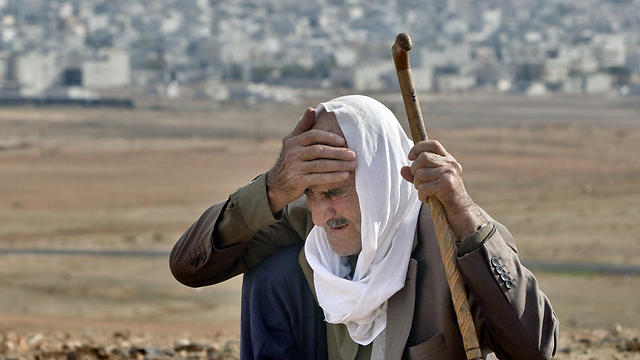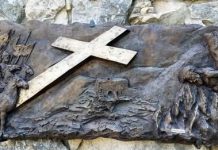The Syrians between a Rock and a Hard Place
Eyad Abu Shakra/ASharq Al Awsat/September 08/15
Russia’s Vladimir Putin is never tired. He is still actively promoting a “peace deal” in Syria that keeps Bashar Al-Assad and those backing him as an integral part of the “solution” to Syria’s crisis, although the only “solution” Assad has sought since March 2011 is best described by “escaping forward” toward more killings, destruction, and disintegration.
The Assad regime’s chosen path for the Syrian popular uprising has been perfectly portrayed during the last few days by murder: through car-bombs that were employed to assassinate Sheikh Wahid Al-Bal’ous, the leader of the Druze uprising in Sweida Province, and the deaths of desperate refugees drowning at sea, as was the case with toddler Aylan Kurdi, his brother, and their mother. In the meantime, Iran is busy redrawing Syria’s demographic map, and those who have planted the Islamic State of Iraq and Syria (ISIS) in the country are harvesting the fruits of their crimes in the shape of Syria’s devastated past, present, and future.
Understandably, the heartrending tragedy of three-year-old Aylan shook the West. In the UK, where only one national newspaper—the Independent—was courageous enough to publish on its front page the picture of the toddler’s little body washed up on the Turkish shore, the overwhelming public response forced Prime Minister David Cameron to shift his initial stance and declare his government’s willingness to welcome Syrian refugees into the UK.
In general, throughout Europe, the reaction to the deeply touching picture, combined with the footage of a flood of refugees crossing barbed-wire border fences, has had similar results; in spite of the shameless sectarian comments from Hungary’s right-wing premier Viktor Orbán, and the not-so-innocent interchangeable usage of the terms “migrants” and “refugees” by circles traditionally known to be hostile to “economic migrants.”
Be it as it may, most European countries have still managed to absorb the shock of tens of thousands Syrian refugees flocking across their frontiers and, temporarily at least, racist and xenophobic voices have kept quiet, allowing the “Aylan Storm” to pass while waiting to fight another day.
Some in Europe have been demanding more is done than simply just allowing in refugees and caring for them, going as far as comparing the current plight of Syrians with that of the Jews during the Holocaust. But the momentum is still lacking as far as what the effective and decisive treatment for the problem should be. The suffering of the Jews did not end in central Europe except after the final defeat of the Nazis. Likewise, the Syrians’ suffering will never end, and waves of refugees will never stop, unless something is done about the root cause of their suffering— that is, bringing down the regime responsible for the ongoing genocide.
This is the stark and simple truth.
Admitting Syrian refugees into the countries which they have reached is surely a necessary step and a moral obligation. However, their crisis has a fundamental political dimension, which means it needs to be tackled as such, not merely as a “natural disaster,” as if it were a case of famine, an earthquake, or floods. The problem is political and so the solution must be political—through taking the perpetrator out of the equation. This is the primary condition for a proper and comprehensive political strategy that aims, first, at rebuilding Syria and what remains of its damaged social and national fabric; and, second, facilitating the war against terror and extremism, both of which have emerged as a reaction against injustice and repression before finding malignant sponsors who have used and exploited them.
It certainly is not enough to just admit refugees while Iran’s Islamic Revolutionary Guard Corps, deploying fighters of several nationalities, carries out sectarian cleansing and then negotiates a population exchange—as we see taking place in the town of Zabadani and the environs of the Barada Valley west of Damascus, and the Shi’ite enclaves of Fou’a, Kefarya, Nubbul, and Zahraa’ in northern Syria. This, indeed, means practically helping the Assad regime and its Iranian backers achieve their aim of partitioning Syria. To make matters even worse, continued Western—namely American—refusal to establish safe havens in northern and southern Syria makes such a scenario more than just viable as it encourages more and lengthier sectarian confrontations, nurtures more extremism, and day-by-day destroys what remains of common denominators still sustaining coexistence between Syria’s constituent communities.
In the north, after Washington gave its backing to the Kurdish militias and thus helped control the whole border area extending from Al-Qamishli in the east to Kobani in the west, we now notice the collapse of much-touted plans for an “ISIS-free zone” between the border towns of Jarabulus and Azaz. The latter plan is now nowhere to be seen although it was thought as being necessary in keeping ISIS at bay, protecting the major city of Aleppo and its countryside, and preventing the establishment of a Kurdish “mini-state” by separating the bulk of Kurdish-controlled areas from the ‘Afrin Kurdish-populated enclave in Syria’s far northwest corner.
In southern Syria, the birthplace of the current uprising, the situation is just as bad. There are actually no signs of real intentions from the international community to keep geopolitical control of the region in spite of its great political importance.
In the south, there are several highly sensitive elements, the most significant of which are:
1) The Israeli presence in the southwest part of the Golan Heights.
2) The Jordanian historical plateau of Hauran, where many clans and tribes are subdivided by the present Syrian–Jordanian border.
3) The Province of Sweida, home to the world’s largest concentration of Druze, some of whose outlying villages have been attacked by extremists including ISIS which has approached the province across the Syrian Desert with the intention of invading both the Sweida and Dera’a provinces. The ISIS encroachment was never checked by the Assad regime’s barrel bombs which have for months on end been raining down on the city of Dera’a and its countryside.
The assassination of Sheikh Al-Bal’ous, founder and leader of the anti-Assad “Sheikhs of Dignity” group, is most definitely part of the regime’s plans for internecine Sunni–Druze confrontations, as is the exploiting of ISIS which was recently expelled from Dera’a Province and has since been trying to return through Sweida, in order to relieve the pressure of the Syrian opposition—including the Free Syrian Army (FSA)—at what is currently one of the regime’s few remaining military outposts.
To describe the gravity of the current situation, I find nothing closer to the truth than the strong words uttered by the Muslim commander Tariq Ibn Ziyad upon crossing the Strait of Gibraltar and setting his ships on fire en route to conquering Spain: “My people, there is no escape [from war]; the sea is behind you, and the enemy before you!”























